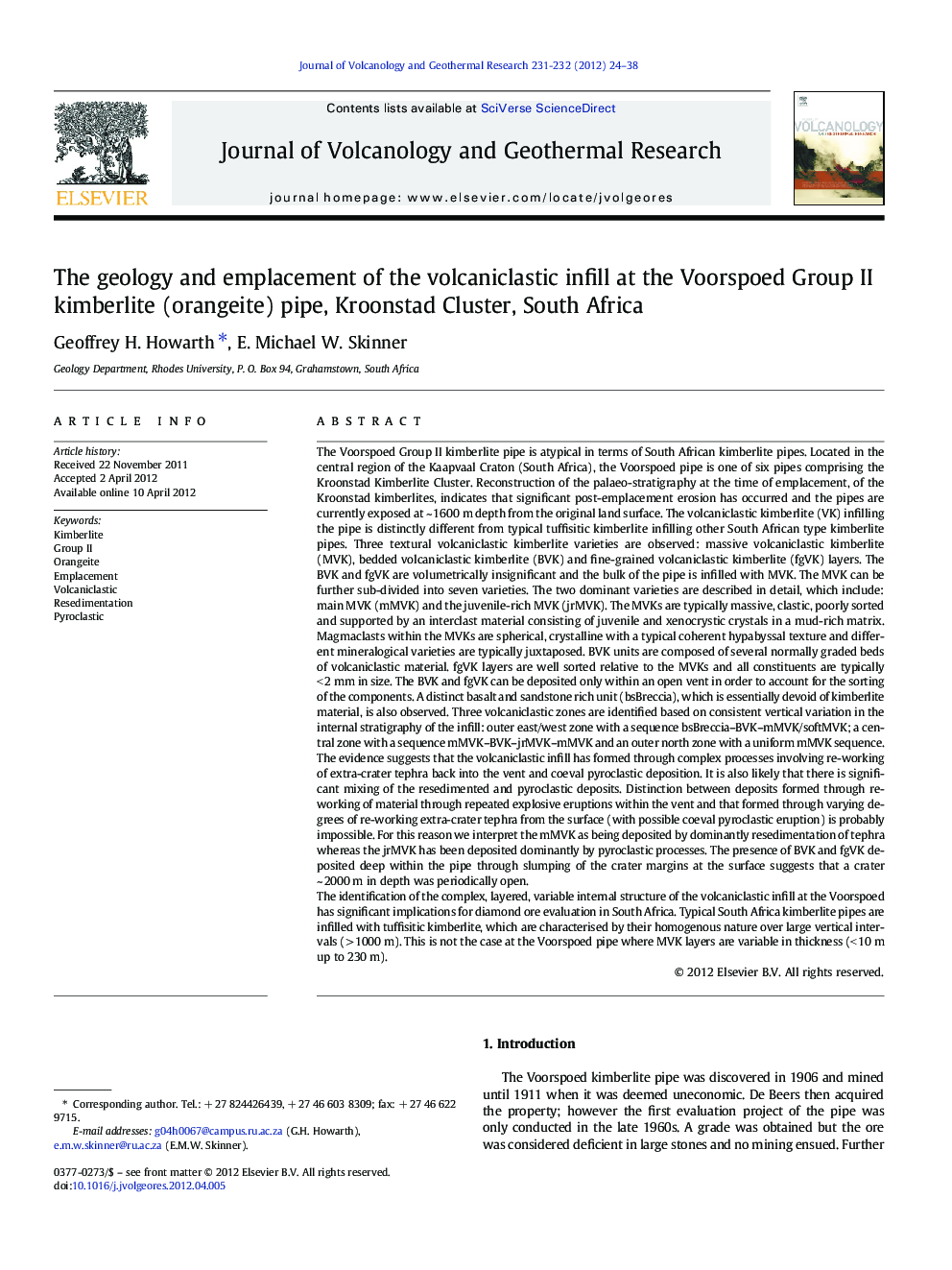| کد مقاله | کد نشریه | سال انتشار | مقاله انگلیسی | نسخه تمام متن |
|---|---|---|---|---|
| 4712677 | 1638381 | 2012 | 15 صفحه PDF | دانلود رایگان |

The Voorspoed Group II kimberlite pipe is atypical in terms of South African kimberlite pipes. Located in the central region of the Kaapvaal Craton (South Africa), the Voorspoed pipe is one of six pipes comprising the Kroonstad Kimberlite Cluster. Reconstruction of the palaeo-stratigraphy at the time of emplacement, of the Kroonstad kimberlites, indicates that significant post-emplacement erosion has occurred and the pipes are currently exposed at ~ 1600 m depth from the original land surface. The volcaniclastic kimberlite (VK) infilling the pipe is distinctly different from typical tuffisitic kimberlite infilling other South African type kimberlite pipes. Three textural volcaniclastic kimberlite varieties are observed: massive volcaniclastic kimberlite (MVK), bedded volcaniclastic kimberlite (BVK) and fine-grained volcaniclastic kimberlite (fgVK) layers. The BVK and fgVK are volumetrically insignificant and the bulk of the pipe is infilled with MVK. The MVK can be further sub-divided into seven varieties. The two dominant varieties are described in detail, which include: main MVK (mMVK) and the juvenile-rich MVK (jrMVK). The MVKs are typically massive, clastic, poorly sorted and supported by an interclast material consisting of juvenile and xenocrystic crystals in a mud-rich matrix. Magmaclasts within the MVKs are spherical, crystalline with a typical coherent hypabyssal texture and different mineralogical varieties are typically juxtaposed. BVK units are composed of several normally graded beds of volcaniclastic material. fgVK layers are well sorted relative to the MVKs and all constituents are typically < 2 mm in size. The BVK and fgVK can be deposited only within an open vent in order to account for the sorting of the components. A distinct basalt and sandstone rich unit (bsBreccia), which is essentially devoid of kimberlite material, is also observed. Three volcaniclastic zones are identified based on consistent vertical variation in the internal stratigraphy of the infill: outer east/west zone with a sequence bsBreccia–BVK–mMVK/softMVK; a central zone with a sequence mMVK–BVK–jrMVK–mMVK and an outer north zone with a uniform mMVK sequence.The evidence suggests that the volcaniclastic infill has formed through complex processes involving re-working of extra-crater tephra back into the vent and coeval pyroclastic deposition. It is also likely that there is significant mixing of the resedimented and pyroclastic deposits. Distinction between deposits formed through re-working of material through repeated explosive eruptions within the vent and that formed through varying degrees of re-working extra-crater tephra from the surface (with possible coeval pyroclastic eruption) is probably impossible. For this reason we interpret the mMVK as being deposited by dominantly resedimentation of tephra whereas the jrMVK has been deposited dominantly by pyroclastic processes. The presence of BVK and fgVK deposited deep within the pipe through slumping of the crater margins at the surface suggests that a crater ~ 2000 m in depth was periodically open.The identification of the complex, layered, variable internal structure of the volcaniclastic infill at the Voorspoed has significant implications for diamond ore evaluation in South Africa. Typical South Africa kimberlite pipes are infilled with tuffisitic kimberlite, which are characterised by their homogenous nature over large vertical intervals (> 1000 m). This is not the case at the Voorspoed pipe where MVK layers are variable in thickness (< 10 m up to 230 m).
► Crater emptied to 2000 m at the time of emplacement.
► Infilled with horizontally layered resedimented volcaniclastic kimberlite units.
► Atypical more similar to the Jwaneng kimberlite and some Lac de Gras kimberlites.
► Initial stages of emplacement similar to typical tuffisitic kimberlite.
► Pipe infilling dominated by gravitational collapse of tuff ring material.
Journal: Journal of Volcanology and Geothermal Research - Volumes 231–232, 15 June 2012, Pages 24–38